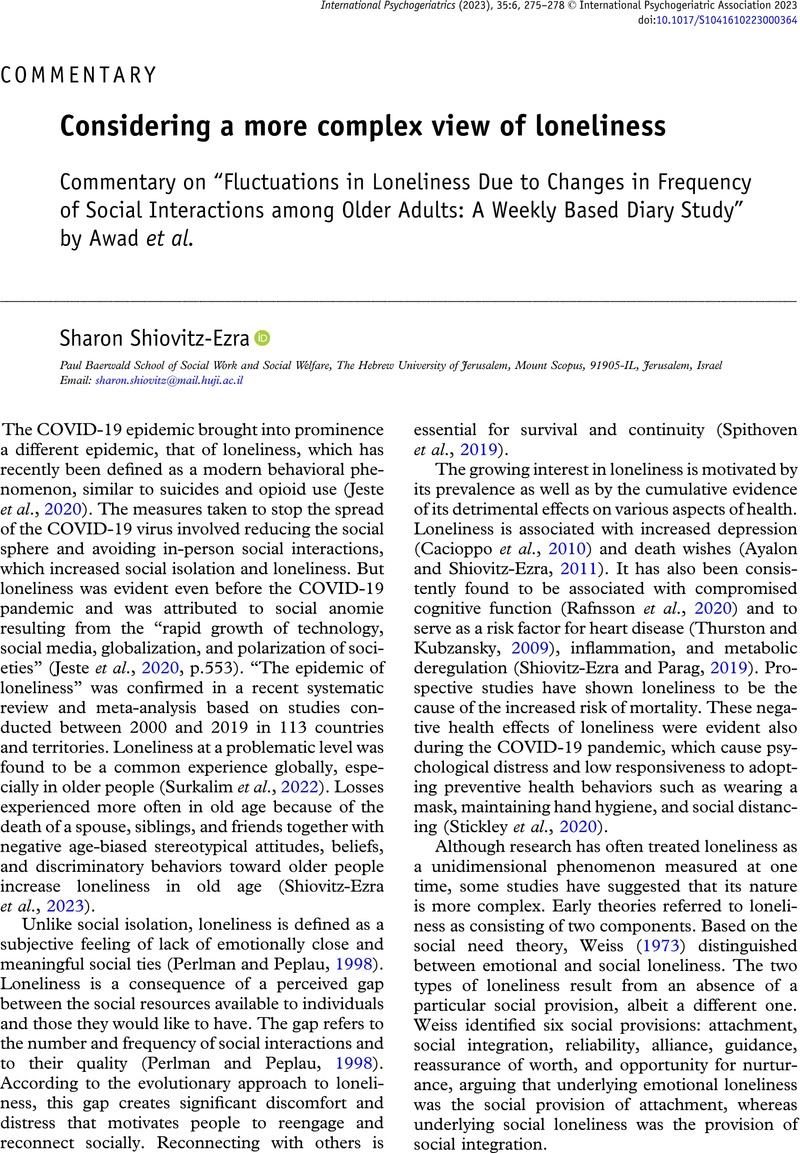No CrossRef data available.
Article contents
Considering a more complex view of loneliness
Commentary on “Fluctuations in Loneliness Due to Changes in Frequency of Social Interactions among Older Adults: A Weekly Based Diary Study” by Awad et al.
Published online by Cambridge University Press: 17 April 2023
Abstract
An abstract is not available for this content so a preview has been provided. Please use the Get access link above for information on how to access this content.

- Type
- Commentary
- Information
- International Psychogeriatrics , Volume 35 , Special Issue 6: Issue Theme: Loneliness in Older Adults , June 2023 , pp. 275 - 278
- Copyright
- © International Psychogeriatric Association 2023
References
Awad, R., Shamay-Tsoory, S. and Palgi, Y. (2023). Fluctuations in loneliness due to changes in frequency of social interactions among older adults: a weekly based diary study. International Psychogeriatrics, 35, 293–303. https://doi.org/10.1017/S1041610223000133.Google Scholar
Ayalon, L. and Shiovitz-Ezra, S. (2011). The relationship between loneliness and passive death wishes in the second half of life. International Psychogeriatrics, 23, 1677–1685.CrossRefGoogle ScholarPubMed
Cacioppo, J. T., Hawkley, L. C., & Thisted, R. A. (2010). Perceived social isolation makes me sad: 5-year cross-lagged analyses of loneliness and depressive symptomatology in the Chicago Health, Aging, and Social Relations Study. Psychology and Aging, 25(2), 453.CrossRefGoogle ScholarPubMed
Creese, B. et al. (2021). Loneliness, physical activity, and mental health during COVID-19: a longitudinal analysis of depression and anxiety in adults over the age of 50 between 2015 and 2020. International Psychogeriatrics, 33, 505–514.CrossRefGoogle ScholarPubMed
De Jong-Gierveld, J. and Raadschelders, J. (1982). Types of loneliness. In: Peplau, L. A. and Perlman, D. (Eds.), Loneliness: A Sourcebook of Current Theory, Research and Therapy (pp 105–119). New York: Wiley-Inter-science.Google Scholar
Hawkley, L. C. and Cacioppo, J. T. (2010). Loneliness matters: a theoretical and empirical review of consequences and mechanisms. Annals of Behavioral Medicine, 40, 218–227.CrossRefGoogle ScholarPubMed
Jeste, D. V., Lee, E. E. and Cacioppo, S. (2020). Battling the modern behavioral epidemic of loneliness: suggestions for research and interventions. JAMA Psychiatry, 77, 553–554.CrossRefGoogle ScholarPubMed
McComb, S. E., Goldberg, J. O., Flett, G. L. and Rose, A. L. (2020). The double jeopardy of feeling lonely and unimportant: state and trait loneliness and feelings and fears of not mattering. Frontiers in Psychology, 11, 563420.CrossRefGoogle Scholar
Perlman, D. and Peplau, L. A. (1998). Loneliness. In: H. S. Friedman (Ed.), Encyclopedia of Mental Health, vol. 2 (pp. 571–581). San Diego, CA: Academic Press.Google Scholar
Rafnsson, S. B., Orrell, M., d’Orsi, E., Hogervorst, E. and Steptoe, A. (2020). Loneliness, social integration, and incident dementia over 6 years: prospective findings from the English longitudinal study of ageing. The Journals of Gerontology: Series B, 75, 114–124. https://doi.org/10.1093/geronb/gbx087.CrossRefGoogle ScholarPubMed
Shiovitz-Ezra, S., Erlich, B. and Ayalon, L. (2023). Short- and medium-term effects of ageism on loneliness experienced during the COVID-19 pandemic. Journal of Applied Gerontology, 0, 073346482311593. https://doi.org/10.1177/07334648231159372.CrossRefGoogle Scholar
Shiovitz-Ezra, S. and Leitsch, S. A. (2010). The role of social relationships in predicting loneliness: the national social life, health, and aging project. Social Work Research, 34, 157–167.CrossRefGoogle Scholar
Shiovitz-Ezra, S. and Parag, O. (2019). Does loneliness get under the skin? Associations of loneliness with subsequent change in inflammatory and metabolic markers. Aging & Mental Health, 23, 1358–1366.CrossRefGoogle ScholarPubMed
Spithoven, A. W. M., Cacioppo, S., Goossens, L. and Cacioppo, J. T. (2019). Genetic contributions to loneliness and their relevance to the evolutionary theory of loneliness. Perspectives on Psychological Science, 14, 376–396.CrossRefGoogle Scholar
Spitzer, N., Segel-Karpas, D. and Palgi, Y. (2022). Close social relationships and loneliness: the role of subjective age. International Psychogeriatrics, 34, 651–655.CrossRefGoogle ScholarPubMed
Stickley, A., Matsubayashi, T. and Ueda, M. (2020). Loneliness and COVID-19 preventive behaviours among Japanese adults. Journal of Public Health (Oxford, England), 43, 53–60. https://doi.org/10.1093/pubmed/fdaa151.CrossRefGoogle Scholar
Surkalim, D. L. et al. (2022). The prevalence of loneliness across 113 countries: systematic review and meta-analysis. BMJ, 376, e067068. https://doi.org/10.1136/bmj-2021-067068.CrossRefGoogle ScholarPubMed
Tao, Q. et al. (2022). Different loneliness types, cognitive function, and brain structure in midlife: findings from the Framingham Heart Study. European Clinical Medicine, 53, 12. https://doi.org/10.1016/j.eclinm.2022.101643.Google ScholarPubMed
Thurston, R. C. and Kubzansky, L. D. (2009). Women, loneliness, and incident coronary heart disease. Psychosomatic Medicine, 71, 836–842.CrossRefGoogle ScholarPubMed
Van As, B. A. L., Imbimbo, E., Franceschi, A., Menesini, E. and Nocentini, A. (2021). The longitudinal association between loneliness and depressive symptoms in the elderly: a systematic review. International Psychogeriatrics, 1–13.Google ScholarPubMed
Weiss, R. S. (1973). The Experience of Emotional and Social Isolation. Cambridge: MIT Press.Google Scholar


